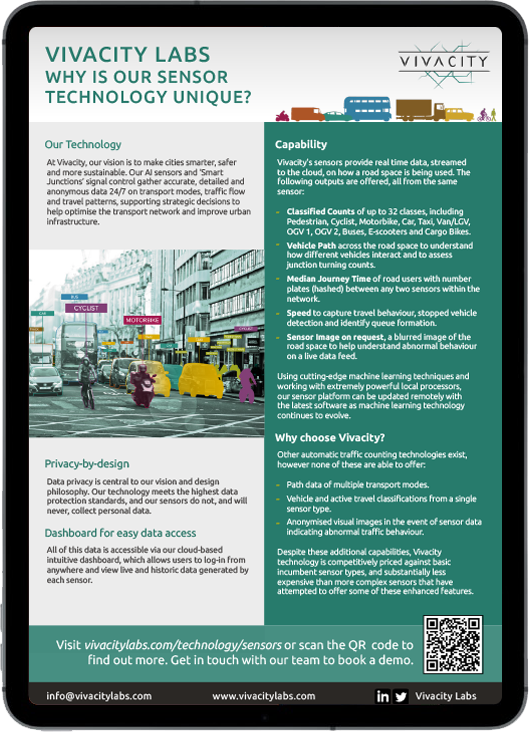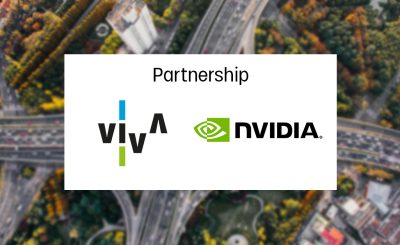Humans continuously strive to understand how people interact with cities, towns and infrastructure. Decision makers are constantly in need of data to monitor current network usage and adapt to changing numbers of travellers, habits and trends. So far, short-term traffic surveys have been the dominant method employed to gather this insight and deliver snapshots of activity at certain times, jumping from event to event.
But behaviors change over time. And patterns form in reaction to events and constantly evolve – a snapshot of two weeks is therefore only good for providing an indicative benchmark. Short-term monitoring can’t be used for any deeper understanding of how behaviors are affected as a result of an intervention, or to identify any deficiencies in a scheme, such as potential dangers or inefficiencies in its design. It leaves the gate open for inaccuracy and inconsistency to slip through.
Short-term measures tend to be based on technology that, whilst often cheaper, is inaccurate in terms of classifying road users and is very light on behavioral insight. But times are changing. Our AI-powered technology and advanced computer vision and Internet of Things (IoT) innovations, on the other hand, can unlock 24/7 365 anonymous monitoring and offer a data accuracy of +97%; not only is it non-stop, but it’s also significantly more accurate than short-term measuring technology.
Discover why our AI-powered computer vision sensors are superior to other traffic monitoring solutions. CLICK HERE TO DOWNLOAD the Technology Guide Now
With this in mind, we outline three reasons why long-term monitoring is the future. A shift in technology to long-term monitoring can:
1. Allow for aggregation over time
By providing a highly accurate and continuous stream of data, you can accrue a mass of data insight over much longer periods of time, making it possible to monitor seasonal effects, create a reduction of temporal anomalies, and observe overarching trends. This can be for a specific time period to see the effects of a specific event, or extended to see the effects of several events and how they relate to each other.
During the pandemic, this allowed for anonymous aggregated data on shifts in travel patterns in response to both seasons and restrictions. This enabled far greater insight into how and when people were travelling and, for example, the impact of street interventions over time. It also offers a continual analysis on trends as we try to adapt our roads to align with sustainable and post-pandemic goals.
This is evidenced in AI sensors being used to assess the School Streets scheme by the Cross River Partnership Viva Programme in Hackney. These were able to successfully demonstrate how the scheme was being used over a couple of months and that it had its desired effect, with an increase in the number of parents and kids walking or cycling to the school coinciding with timed street changes to vehicle access. This data can be extended over several months and years if necessary.
2. Reduce uncertainty and improve consistency
With short-term surveys and technology, there are large gaps to fill in between data being observed. This leads to missing information, uncertainty and a lack of consistency when trying to analyse data over time, meaning decision makers are often having to make judgement calls based on whatever insight they have. Furthermore, they often can’t differentiate between what travel modes are being used.
Unlike incumbent above and below ground detection methods, AI technology not only provides a high-fidelity and continuous stream of data 24/7, but offers accurate and anonymous multi-modal detection of 13 main road user classes. For example, limited to the detection of metallic road users, induction loops do not detect pedestrians and cyclists, and cannot easily differentiate between a car and a van.
In Manchester, TfGM needed the means to better understand how its active transportation schemes and junctions were being used across the city. This has seen around 100 AI sensors be installed across the region to monitor active transportation trends, joined by our Smart Junctions operating at specific sections. These Smart Junctions are able to anonymously monitor all modes of transport, identifying trends and adapting signal control to optimize road use in real time. Combined, this creates a network of travel data insight in the city that can be aggregated and analysed over time
3. Connect with other technology to create a hub of varied data
By operating through the IoT and advanced wireless networks such as 5G, our AI sensors are able to connect with other sensors and technology to gain aggregated insights and comparisons on different factors. This can be particularly helpful when trying to assess and evaluate cause and effects on particular roads, junctions and areas.
For example, we recently announced our partnership with Vaisala, a global leader in weather, environmental and industrial measurements, to drive sustainability in the travel industry. Air quality and weather sensors are being installed across a number of sites alongside our traffic sensors to provide researchers with the opportunity to explore the subtle differences in traffic flows as the weather changes over time and seasons.
It’s an example of how collaboration in long-term monitoring can enhance safety, efficiency and decision making, providing detailed insights into both street level and large-scale air quality changes across a region from both a traffic and weather perspective.
As we look to progress the future of smart cities, the more interconnected our technology can become, the more valuable its data will be in advancing our cities’ ecosystems and citizens’ way of life. At the heart of this progression will be long-term monitoring, providing insights on seasonal trends with high accuracy, detail and consistency, helping to produce an interconnected hub of diversified data.
Find out how legacy traffic monitoring technologies compare to one another, and discover how computer vision sensors can offer accurate insights for long-term monitoring schemes.
DOWNLOAD THE TECHNOLOGY GUIDE NOW
Get in touch with the Viva team and let us show you more about how our AI-powered computer vision sensors can help your maximise the monitoring of your schemes.
Like our content? Sign up to our newsletter and receive the latest updates in your inbox.
Sign-Up









